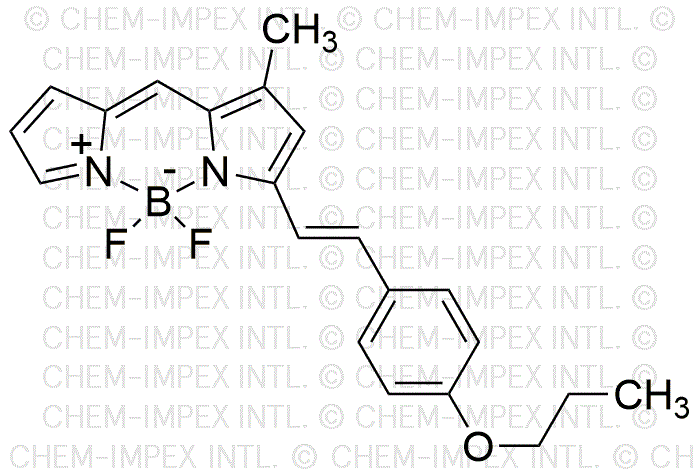4,4-Difluoro-1-methyl-3-(4-propoxystyryl)-4-bora-3a,4a-diaza-s-indacene is widely utilized in research focused on:
- Fluorescent Probes: This compound serves as a highly effective fluorescent probe in biological imaging, allowing researchers to visualize cellular processes in real-time.
- Organic Light Emitting Diodes (OLEDs): Its unique optical properties make it suitable for use in OLEDs, enhancing the efficiency and color purity of displays.
- Photodynamic Therapy: In the medical field, it can be applied in photodynamic therapy for cancer treatment, where its fluorescence can help target and destroy cancer cells.
- Sensor Technology: The compound is used in developing sensors for detecting environmental pollutants due to its sensitivity to specific chemical changes.
- Research and Development: It is a valuable tool in materials science for synthesizing new materials with tailored optical properties, aiding in the advancement of nanotechnology.
Información general
Propiedades
Seguridad y normativas
Aplicaciones
4,4-Difluoro-1-methyl-3-(4-propoxystyryl)-4-bora-3a,4a-diaza-s-indacene is widely utilized in research focused on:
- Fluorescent Probes: This compound serves as a highly effective fluorescent probe in biological imaging, allowing researchers to visualize cellular processes in real-time.
- Organic Light Emitting Diodes (OLEDs): Its unique optical properties make it suitable for use in OLEDs, enhancing the efficiency and color purity of displays.
- Photodynamic Therapy: In the medical field, it can be applied in photodynamic therapy for cancer treatment, where its fluorescence can help target and destroy cancer cells.
- Sensor Technology: The compound is used in developing sensors for detecting environmental pollutants due to its sensitivity to specific chemical changes.
- Research and Development: It is a valuable tool in materials science for synthesizing new materials with tailored optical properties, aiding in the advancement of nanotechnology.
Documentos
Hojas de datos de seguridad (HDS)
La SDS proporciona información de seguridad completa sobre la manipulación, el almacenamiento y la eliminación del producto.
Especificación del producto (PS)
La PS proporciona un desglose completo de las propiedades del producto, incluida la composición química, el estado físico, la pureza y los requisitos de almacenamiento. También detalla los rangos de calidad aceptables y las aplicaciones previstas del producto.
Certificados de análisis (COA)
Busque certificados de análisis (COA) ingresando el número de lote del producto. Los números de lote y de partida se pueden encontrar en la etiqueta de un producto después de las palabras "Lote" o "Lote".
Número de catálogo
Número de lote/lote
Certificados de origen (COO)
Este certificado de origen confirma el país en el que se fabricó el producto y también detalla los materiales y componentes utilizados en él y si se deriva de fuentes naturales, sintéticas u otras fuentes específicas. Este certificado puede ser necesario para cumplir con las normativas aduaneras, comerciales y regulatorias.
Número de catálogo
Número de lote/lote
Hojas de datos de seguridad (HDS)
La SDS proporciona información de seguridad completa sobre la manipulación, el almacenamiento y la eliminación del producto.
DownloadEspecificación del producto (PS)
La PS proporciona un desglose completo de las propiedades del producto, incluida la composición química, el estado físico, la pureza y los requisitos de almacenamiento. También detalla los rangos de calidad aceptables y las aplicaciones previstas del producto.
DownloadCertificados de análisis (COA)
Busque certificados de análisis (COA) ingresando el número de lote del producto. Los números de lote y de partida se pueden encontrar en la etiqueta de un producto después de las palabras "Lote" o "Lote".
Número de catálogo
Número de lote/lote
Certificados de origen (COO)
Este certificado de origen confirma el país en el que se fabricó el producto y también detalla los materiales y componentes utilizados en él y si se deriva de fuentes naturales, sintéticas u otras fuentes específicas. Este certificado puede ser necesario para cumplir con las normativas aduaneras, comerciales y regulatorias.


